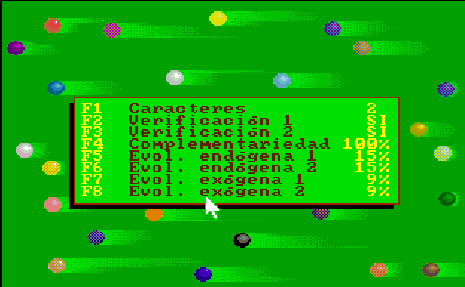3. SHARED BILLIARDS GAMES RULES
Key F3 on the Options Menu controls the difficulty level.
There are four difficulty levels: in the first three, the snooker table has six pockets, and the aim is to pot a ball into a pocket. In the fourth, there are no pockets.
Before beginning his turn, each player may choose the impact, angle, and. The function of each key will become apparent while playing. If the chosen key has no function, a help screen will appear containing all possible options.
An excellent computer billiards tip is the F9 function key, which suggests a shot - maximum three -, and F10, which saves the game at a specific stage, allowing the game to reloaded with Alt-F10 or F6 from the Options Menu.
Although it would be possible to play without a mouse, the choices of angle, impact, and spin are much more comfortable with it. A small amount of practice will be enough to see how it works. Nevertheless, it is useful to note that placing the mouse pointer below the sports players' names on the screen, and clicking the left mouse button makes a shot.
The Tab key forces the computer players to shoot without further delay, except in Tournament and the BEEPS Cups.
The game rules are the usual ones, and all actions are automatic.
Only one game or a tournament is possible to save at a specific moment, and it will replace the previously saved game or tournament.
There are two BEEPS Cups. The numbers 1 or 2 appear in the red ball in the top left-hand corner of the screen. The second Cup can only load from the Options Menu; it begins at a higher level, and help function is not available. To add a new player, just highlight the players' column and press Enter, then type the desired name.
In BEEPS Cup, when choosing a game, the program selects a computer player as the opponent and a level of difficulty depending on the accumulated points the human player has. As such, the more points one has, the better the computer player will be.
The maximum score is 200 points, 20 for French Billiards, 40 for each of the Esnuka games, and 30 for Snooker and Pool.
3.a) ESNUKA, THE COMPUTER GAME OF EVOLUTION (SPANISH BILLIARDS)
See shared rules.
To play billiards games of evolution is almost compulsory to know how to play pool billiards, and it would be better to know how to play snooker, because Esnuka is a variation of both plus a few new ideas to make a simulation of an evolutionary process.
Therefore, in Esnuka computer educational games, it is possible to apply billiards tips and pool and snooker trick shots.
The CEL genetic algorithms and Mendel's laws support the evolutionary steps of the balls of these educational games. It is advisable to read and watch the option of the computer simulation of evolution.
The game aims to make the color of the player's ball into as highly evolved color as possible, through evolutionary processes while potting the balls.
The most evolved colors are either black or white, depending on the scale. Function key F1 in the Options Menu changes the color scale.
There are four difficulty levels. In the first three, the Snooker table has six pockets, and a ball must go into a pocket in order to start the evolutionary process. In the fourth, the table has no pockets, and hitting an appropiate ball will begin the above process.
Although it might seem a bit complex to learn how to play billiards games of evolution at the beginning, the computer will help because all the counting is fully automatic.
At the same time, there is no need to understand the genetic algorithms; the player would finally get the intuitive idea of the evolutionary processes.
There are two types of balls on the table and the corresponding to the players: mono or multi-colored balls. When the player's ball is mono-colored, only multi-colored balls may be hit or potted (depending on the difficulty level). Vice versa, if no ball is hit or potted, a foul will be given, a black or white circle will appear in the middle of the player's ball, and it will be the next player's turn.
The size of the mentioned circle represents the number of fouls accumulated by the player. The genes are carriers of these fouls and, as such, can change through evolutionary processes. Furthermore, the number of fouls represents the probability of a genetic accident throughout these steps; an accident means the player reduces to the lowest state within the scale.
When a ball on the table reaches the maximum state possible, it will not re-spotted, but remains in the pocket.
The configuration parameters of the evolutionary process shows on the Conditions Menu.

To understand how to play Esnuka with the option of special evolution, we must bear in mind that the rules are similar to standard options except that the genes maintain their gender and, as such, jumps in scale are double those of the standard game. Furthermore, when the gender corresponds to multi-colored balls, no evolution takes place under the CEL.
Actually, according to the CEL, Evolution would take place due to the endogenous evolution rate; in other words, they gained through the learning from the information contained in the gene corresponding to the same character but from the other parent. However, in this game, no evolution takes place to achieve the desired visual impact: that one of the two sexes does not evolve in the same way as the other.
This option is incompatible with those of color inversion and two characters.
